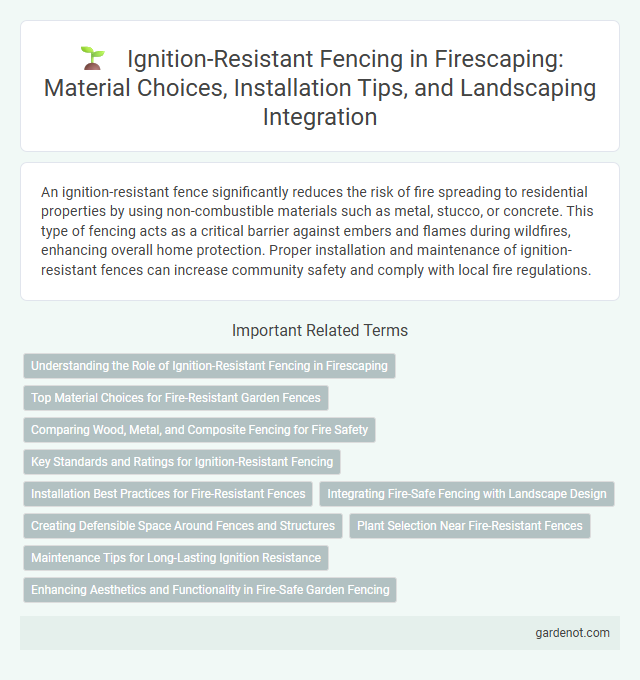An ignition-resistant fence significantly reduces the risk of fire spreading to residential properties by using non-combustible materials such as metal, stucco, or concrete. This type of fencing acts as a critical barrier against embers and flames during wildfires, enhancing overall home protection. Proper installation and maintenance of ignition-resistant fences can increase community safety and comply with local fire regulations.
Understanding the Role of Ignition-Resistant Fencing in Firescaping
Ignition-resistant fencing plays a critical role in firescaping by reducing the risk of fence materials catching fire and transmitting flames to nearby structures. Constructed from non-combustible materials such as metal or fiber-cement, these fences act as a protective barrier during wildfires, preventing ignition from embers or direct flame contact. Integrating ignition-resistant fencing into a defensible space enhances overall fire resilience and safeguards property against cascading fire hazards.
Top Material Choices for Fire-Resistant Garden Fences
Top material choices for ignition-resistant fences include metal, concrete, and fiber cement, as these materials provide superior fire resistance by preventing sparks and embers from igniting the structure. Metal fences, particularly those made of steel or aluminum, offer durability and non-combustibility, making them ideal for fire-prone areas. Fiber cement and concrete provide both fire resistance and structural integrity, ensuring long-lasting protection for firescaped gardens.
Comparing Wood, Metal, and Composite Fencing for Fire Safety
Ignition-resistant fencing plays a crucial role in firescaping by reducing the risk of fire spread around homes. Metal fences offer superior fire resistance compared to wood, which can easily ignite and contribute to fire propagation. Composite fencing, made from fire-retardant materials, provides a balance between durability and ignition resistance, making it a safer alternative in wildfire-prone areas.
Key Standards and Ratings for Ignition-Resistant Fencing
Ignition-resistant fences are rated based on standards such as ASTM E84, which measures flame spread and smoke development, and the Wildland-Urban Interface (WUI) codes that require materials to resist ignition from embers and radiant heat. Class A fire ratings are crucial for fences, indicating the highest level of flame resistance, ensuring durability and safety in fire-prone areas. Compliance with these standards and ratings reduces fire risk by preventing fence ignition and limiting fire spread near structures.
Installation Best Practices for Fire-Resistant Fences
Installing ignition-resistant fences requires selecting non-combustible materials such as metal, masonry, or fiber cement to effectively block embers and reduce wildfire risks. Proper spacing of fence boards and ensuring no debris accumulates near the base prevents ember entrapment and flame spread. Regular maintenance, including clearing vegetation within three feet of the fence, enhances fire resistance and prolongs the fence's protective function.
Integrating Fire-Safe Fencing with Landscape Design
Ignition-resistant fences constructed from non-combustible materials such as metal or masonry play a vital role in creating fire-safe landscapes. Integrating these fences with fire-resistant plants and strategically placed hardscape elements enhances the overall effectiveness of the defensible space against wildfires. Proper spacing between the fence and vegetation reduces fuel continuity, minimizing fire spread risks while maintaining aesthetic appeal.
Creating Defensible Space Around Fences and Structures
Ignition-resistant fences, constructed from non-combustible materials such as metal or masonry, play a crucial role in creating defensible space around properties by preventing the spread of fire to structures. Maintaining a clearance of at least 5 feet around fences, free of dry vegetation and combustible debris, significantly reduces the risk of ignition and flame contact during wildfires. Strategic placement of ignition-resistant fencing, combined with regular maintenance and landscaping practices, enhances overall fire resilience and protects homes from ember attacks.
Plant Selection Near Fire-Resistant Fences
Selecting fire-resistant plants near ignition-resistant fences significantly reduces wildfire risk by minimizing flammable materials adjacent to property barriers. Species such as succulents, lavender, and thyme offer low fuel loads and high moisture content, creating effective defensible spaces. Proper spacing and regular maintenance of these plants further enhance the fence's ability to resist ignition during fire events.
Maintenance Tips for Long-Lasting Ignition Resistance
Regularly clear debris, leaves, and vegetation near ignition-resistant fences to maintain their fire-resistant properties and prevent heat buildup. Inspect fences frequently for any signs of damage or wear, repairing or replacing compromised sections promptly to ensure continuous protection. Apply fire-retardant treatments as recommended by the manufacturer to enhance durability and sustain ignition resistance over time.
Enhancing Aesthetics and Functionality in Fire-Safe Garden Fencing
Ignition-resistant fences combine fire-safe materials such as metal, masonry, and fiber cement to enhance garden safety while maintaining aesthetic appeal. These fences act as effective barriers against embers and flames, reducing fire risk without compromising design versatility. Incorporating ignition-resistant fencing supports a functional landscape that prioritizes both protection and visual harmony in fire-prone areas.
Ignition-resistant fence Infographic

 gardenot.com
gardenot.com